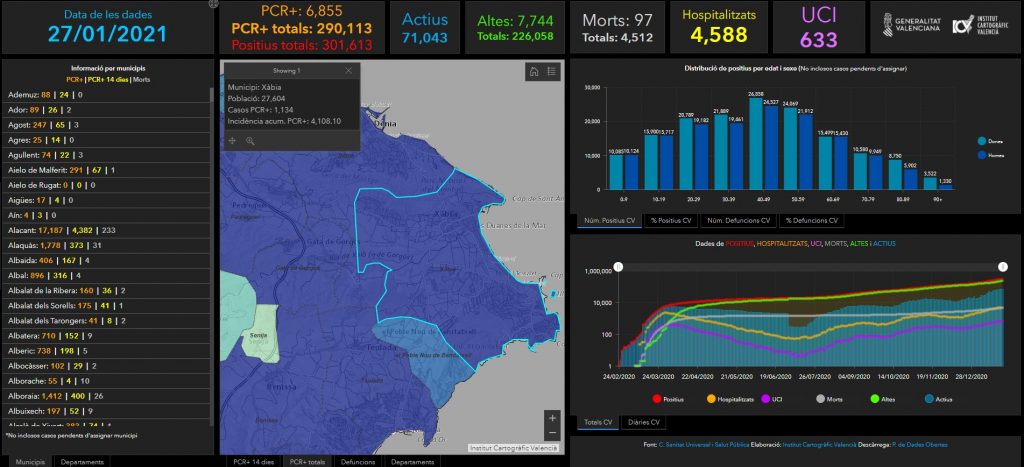Xàbia reports 73 new positive cases; Marina Alta 587
Xàbia’s total reaches 1,134 since the pandemic began; the Marina Alta totals 7,595.

This is the latest information on the status of the health situation in Xàbia, the Marina Alta, the Comunidad Valenciana and across Spain.
For more information, please refer to the links given at the bottom of the page as our report is based on the official figures given in these sources.
Xàbia
Xàbia has seen 73 new positive cases reported since the last update on Tuesday 26th January, taking the total to 1,134 positive cases found in Xàbia since the pandemic began.
Latest Data (27/01/2021)
14-Day Cumulative Rate (IA): 985.36 –
Positive PCR Tests in the past 14 days: 272 ↓
Total Positive Cases: 1,134
Total Deaths: 6
Marina Alta
The Dénia Health Authority, which covers the Marina Alta region, has recorded 587 new infections since the last update, bringing the total to 7,595 positive cases since the crisis began.
The new infections include:
- Dénia – 124
- Calp – 110
- Xàbia – 73
- Benissa – 64
- Teulada – 49
- Pedreguer – 32
- Ondara – 29
- Gata de Gorgos – 25
- Poble Nou de Benitatxell – 5
There has been 1 new death since the last update (in El Vergel), bringing the total to 102 since the crisis began.
Vall de Gallinera remains the only municipality in the Marina Alta not to have recorded a single positive case.
Latest Data (27/01/2021)
14-Day Cumulative Rate (IA): 1,085.94 ↑
Positive PCR Tests in the past 14 days: 1,877 ↑
Comunidad Valenciana
As of 28/01/2021, 6,855 new cases of coronavirus have been confirmed through PCR or antigen tests; by province, the distribution of these new cases is 443 in Castellón, 3,195 in Valencia, and 3,197 in Alicante. In total, 290,113 positive cases have been recorded in the Comunidad Valenciana. There are currently 46 unassigned cases.
Outbreaks
There have been a total of 70 new outbreaks of the disease across the Comunidad Valenciana; by province, the distribution is 9 in Castellón, 46 in Valencia, and 15 in Alicante, of which there were none recorded in the Marina Alta region.
There have been 47 outbreaks of the coronavirus in the Marina Alta in 2021.
Active Cases
The data shows that there are currently 71,043 active cases of COVID-19 in the Comunidad Valenciana, with represents 23.55% of the total number of positives cases recorded.
Deaths
There have been 97 deaths from COVID-19, bringing the total for the Comunidad Valenciana to 4,588 people; by province, the distribution of the deaths is 539 Castellón, 2,351 Valencia, and 1,622 Alicante.
Hospitalization
There are 4,588 people currently in hospitals across the Comunidad Valenciana who are being treated for the COVID-19 infection; by province, the distribution is 458 Castellón with 47 patients in ICU, 2,319 Valencia with 341 in ICU, and 1,811 Alicante with 245 in ICU.
Recoveries
7,744 recoveries from COVID-19 have been registered; in total, 226,058 people in the Comunidad Valenciana have overcome the disease since the pandemic began.
Vaccination
112,612 doses of the vaccination have been administered throughout the Comunidad Valenciana: 109,948 Pfizer/BioNtech and 2,664 Modena. Up to now, 11,151 people has completed the vaccination programme in our region.
Latest IA Rate by Health Authority (28/01/2021)
↑ up on 14 days ago
↓ down on 14 days ago
2,785.09 – Alcoi ↑ 56%
2,335.31 – Elx ↑ 862%
2,284.81 – Elda ↑ 99%
1,744.87 – Xàtiva-Ontinyent ↑ 62%
1,589.64 – Valencia Dr.Peset ↑ 104%
1,468.36 – La Ribera ↑ 10%
1,431.39 – Valencia La Fe ↑ 95%
1,425.55 – Requena ↑ 34%
1,406.46 – Valencia Clinic La Malva Rosa ↑ 83%
1,404.63 – La Marina Baixa ↑ 181%
1,403.93 – Sagunt ↑ 95%
1,391.66 – La Plana ↑ 111%
1,376.31 – Elx-Crevillent ↑ 445%
1,358.17 – Alacant Hospital General ↑ 224%
1,341.97 – Valencia Hospital General ↑ 93%
1,331.57 – Orihuela ↑ 261%
1,281.71 – Vinaros ↑ 79%
1,262.46 – Manises ↑ 427%
1,251.46 – Valencia Arnau de Vilanova-Llíria ↑ 117%
1,251.08 – Sant Joan de l’Alacant ↑ 141%
1,085.94 – Dénia ↑ 22%
1,028.95 – Gandía ↑ 116%
897.46 – Castelló ↑ 125%
530.04 – Torrevieja ↑ 949%
News
IN DETAIL – Decree 2/2021 New Restrictions in the Comunidad Valenciana, a full translation of the Presidential Decree 2/2021 on the restrictions to limit movement and social interaction is available here.
Spain
As of 28/01/2021, Spain has recorded 2,705,001 cases of COVID-19 infection, an increase of 34,899 on the previous day. The 14-day IA rate1 is 889.93, no change from the previous update. The positivity rate2 has dropped to 15.84%; it has been dropping for seven successive days.
There are 30,726 people currently being treated for COVID-19 in hospital, of which 4,608 are in ICU wards. As of 28/01/2021, 24.0% of general wards and 42.8% of ICU beds are occupied by COVID-19 patients.
As of 28/01/2021, 57,806 people have lost their lives to COVID-19, a rise of 515 on the previous day.
As of 27/01/2021, 1,395,618 doses of the vaccination have been administered throughout the country – 1,369,272 Pfizer/BioNtech and 26,346 Modena – representing 78.9% of all vaccines delivered to Spain. A total of 192,759 have completed the vaccination course, all with the Pfizer/BioNtech vaccine, representing 13.81% of vaccines already administered-
Latest IA Rate by Autonomous Region (28/01/2021)
↑ up on 14 days ago
↓ down on 14 days ago
1,438.40 – Comunidad Valenciana ↑ 89%
1,414.68 – Castilla y León ↑ 103%
1,338.44 – Murcía ↑ 51%
1,324,19 – La Rioja ↑ 79%
1,238.20 – Castilla-La Mancha ↑ 59%
1,224.86 – Extremadura –
1,004.78 – Melilla ↑ 78%
994.79 – Madrid ↑ 42%
886.02 – Andalucia ↑ 91%
771.32 – Aragón ↑ 52%
751.81 – Galicia ↑ 91%
631.86 – Baleares ↓ 1%
573.47 – Cataluña ↑ 2%
566.29 – Asturias ↑ 120%
549.68 – Ceuta ↑ 37%
493.26 – Navarra ↑ 46%
492.62 – País Vasco ↑ 61%
397.54 – Cantabria ↑ 18%
186.45 – Canarias ↑ 14%
News
Hospital admissions across Spain have fallen for the first time this year which, if the downward continues, would seem to indicate that the country has reached the peak of the third wave. However, the ICU wards are still under intense pressure, with COVID-19 patients occupying almost 43% of all ICU beds in Spain.
Delivery delays are complicating the vaccination programme in Spain, after Moderna admitted that deliveries would be pushed back by a few days whilst supplies of AstraZeneca would also be taking longer than expected to be delivered. As a result, most autonomous regions are being forced to make small adjustments to their original vaccination plans, with Madrid announcing that it was putting a two-week freeze on first-dose jabs to ensure that every who had their first shot receives their second jab within the required deadline.
The Spanish Government is asking regional administrations to keep an eye on their vaccinations programmes as reports continue to reveal that hundreds of individuals have been jumping the queue and receiving their jabs ahead of time, including several politicians, a bishop, and an army general.
A new report has revealed that the COVID-19 health crisis dealt a several blow to the job market in Spain, with 622,600 jobs lost during 2020 and unemployment climbing to 3.71 million. The unemployment rate reached 16.1%. An EPA survey also found that 1 in 10 people in employment worked from home for more than half of each working week during 2020.
Finally, almost a year on from the start of the pandemic, the debate about face masks continues with health experts warning than non-medical masks are not safe. Much more is known about how the virus spreads and some countries, such as France and Germany, have started to ban homemade masks from being worn in the public and have issued decrees outlining the type of mask that should be worn, such as surgical, FFP2 and fabric masks made to category 1 standards. In Spain, homemade masks are coming under closer scrutiny with some health experts saying that they are not subject to specific requirements and should not be allowed, that everyone should be wearing PPE masks because they are most effective at reducing the spread of infection. The Spanish Government has yet to comment.
Data Explanation
1 The IA rate is the number of new cases of COVID-19 per 100,000 inhabitants over the past 14 days. It is considered the most accurate measure of the spread of the virus. A rate above 250 indicates an ‘Extreme Risk’ that the infection is spreading. The aim of the Spanish government is to lower this rate to 25.
2 The positivity rate refers to the percentage of all COVID-19 tests carried out which have come back positive. A high figure means that it doesn’t take many tests to come across a positive result.



